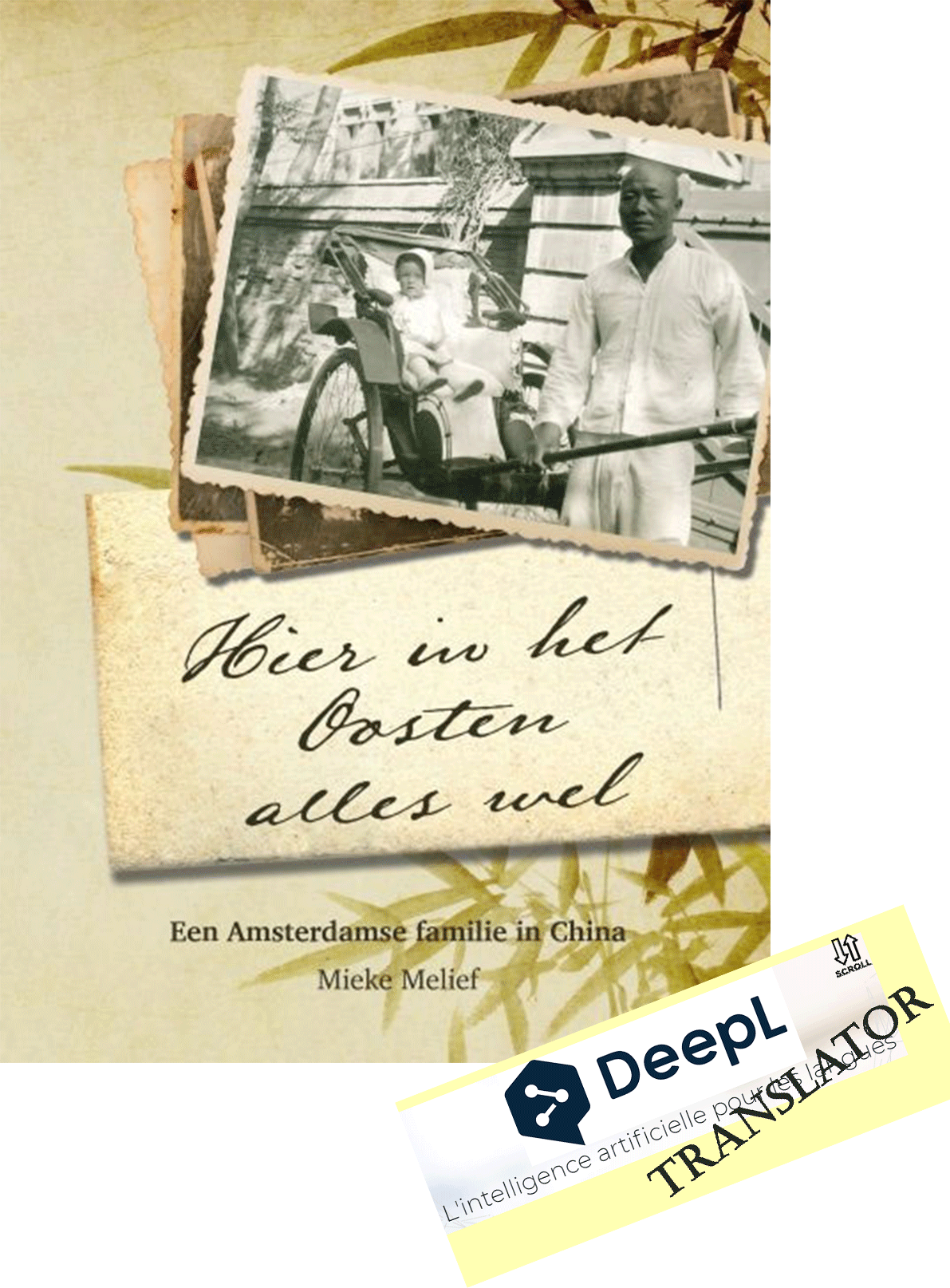
- by Annie deJongh
[Exerpts] ...
[...]

According to Leo his lordly uncle was not
so exuberant, but he must have joined his former housemate chaplain Hubert Schlooz. He did leave a flattened thumb to the camp, because many had to do work for which they were not trained, such as carpentry.
Jan de Bakker and other mainly young missionaries were disappointed by the fact that all fathers and nuns were removed from the civilian camp at the hands of the Vatican. Bakker says: `I thought it was stupid, we shouldn’t have been treated better than the rest. We were right there.
We all wanted to stay behind, but we weren’t allowed to. You turned it into study time.
You had all kinds of specialists there and from different congregations.
What are we going to do later? There was a revolution in thinking. Contacts with people who weren’t Catholic, dissenters, all kinds of religions. Had opened our eyes. “Lectures, theatre, music, disputes.
After most Catholic priests and nuns had left, a small unit of four priests and five sisters remained for the spiritual care of the internees, for the masses and for help in the church. The priests were, apprehensive; they had nothing to do with the Vatican and took care of the families & children in the camp.
http://www.weihsien-paintings.org/NormanCliff/people/individuals/Hanquet/p_Hanquet_pic.htm#56
Au camp de Weihsien, il y avait 1,500 internés (dont 300 catholiques) de 13 nationalités, en majorité des Anglais et des Américains. Après le départ des missionnaires, autorisés par les Japonais à vivre à Peiping (6 évêques, 400 prêtres, 200 religieuses), il ne restait en fait de missionnaires que 10 prêtres : 2 franciscains américains, 6 Auxiliaires des Missions, 1 Bénédictin belge et 1 jésuite belge. Il y avait également 6 soeurs américaines. 25 personnes reçurent le baptême au camp, toutes converties du protestantisme.
Parmi elles, Miss Brayne, une Anglaise, missionnaire de la «China Inland Mission».
Especially in the beginning, when there were still many Catholic monks in the camp, impressive and colourful masses were celebrated.
More than three hundred priests and one hundred nuns sang the Mass of Angels.
At Christmas there was a Mass on Christmas Eve and a Night Mass. At Easter there was an Easter vigil. Musical instruments were played. Later there were still beautiful masses on Christmas Eve and a night mass with the religious who stayed behind. Groups came together to pray or to study the Bible.
The priests were busy with baptisms, confessions of faith and marriages. Two hundred and fifty Catholic marriages alone were blessed. In the Assembly Hall several services were held on Sundays, including a Catholic high mass and an Anglican service.
In the afternoon there was a meeting of the Union Church and the Brass Bands of the Salvation Army. On Thursday there was a separate performance of these Brass Bands every week, for which there was a lot of interest. About twenty Catholic orders were represented in the camp.
The Trappists gave up their vow of silence.
It was possible to confess in quiet places. Children were also prepared for their First Holy Communion.
The Jewish community had its own rites.
Protestants organised all kinds of activities for their religious community.
Sometimes things clashed between people with different religious beliefs, but this did not lead to serious conflicts. The camp, which mainly taught the residents to be open-minded, had a levelling effect on social and religious differences, because a powerful ecumenical élan arose.
At first there were also many mutual prejudices between the missionaries, who were seen as hypocritical fanatics and the taipans, which had gone to China for economic reasons and were seen as harsh, immoral people who exploited the Chinese and did not allow them to join the urban concessions and their clubs.
Many were doctors or teachers and worked very hard in that capacity.
In Weihsien they organised sporting and musical activities, which guided people through periods of hard work, lack of food and little perspective.
Music education played a major role in Anneke’s life in the camp. Many people had their own instrument with them.
There were a few gramophones and many ebonite records brought by the prisoners.
Interested people gathered regularly in the evening, usually in Moongate Park, to listen to those records. All kinds of classical concerts and recordings of chamber music were played in the open air. Everyone took stools with them to sit on. The other residents were aware that music was being listened to and quietly walked around Moongate Park.
During the first six months the Dutch Fathers organized music evenings, which were called Sing Song or the Sunday Evening Concerts and which became more and more extensive. They cheered the camp residents up tremendously. The conservative Belgian Bishop De Smedt played the accordion.
[excerpt]
Nice young fathers, who had always lived in monasteries, suddenly came to Weihsien, Shantung and became very popular.
They sometimes had romances with beautiful young girls.
Because of their direct contact with young women and their constant closeness they fell in love and vice versa.
Thus Anneke remembers a certain father, a handsome Franciscan, with whom she moped up as a blossoming adolescent and with whom she was secretly in love.
All sorts of barriers also fell away with the clergy. The camp became an ecumenism anyway. There were also a number of bishops and Anneke and her family with their friends — the priests of the Yung-Ping-Fu monastery — who had stayed with them in Tientsin often and to annoyance.
It often happened that a Mass with Three Lords was celebrated, because there were countless priests available. Fortunately, Anneke said, we had several bishops in the camp, including Bishop Lebouille and Bishop Geurts, Lazarists, and Bishop Pessers, a young French bishop who had once visited the De Jongh family in Tientsin and who would later baptise Anneke’s youngest brother, Paultje.
On August 12, a young missionary, Nico Dames, died of cancer. He was given the most beautiful funeral the camp residents had ever seen or would see in the rest of their lives. The whole camp ran out and the funeral service was led by the bishops who lived in the camp.
In addition to a large number of believers, all the religious, many of whom were musical and sang the polyphonic hymns during Mass from full breasts, were present at the service in full oratorio (as far as possible). Anneke remembers this bearded dead person well.
[excerpt]
A well-known Lazarist, was Father Verhoeven, who was very good at drawing and painting. He made numerous drawings and paintings of the buildings and grounds in the camp.
He also drew an accurate map of Weihsien.
Virtually no photographs were taken during the camp period, so Father Verhoeven’s pictures are very valuable to the former camp residents, their relatives, and those interested.
[excerpt]
Unfortunately, most nuns and fathers had to leave the camp after six months. The internees were heartbroken, Anneke says.
The nuncio, the diplomatic representative of the Vatican, issued a decree on behalf of the Pope, stating that the Catholic religious had renounced their own nationality by entering the monastery and going on missions. They were first and foremost Catholics and members of the Vatican; the Vatican City was thus their homeland.
They no longer had allied nationality.
The nuncio also contacted the Japanese about this and they judged that the Catholic monks were unjustly imprisoned.
All of a sudden they all had to go back to the monasteries.
Presumably, the Pope feared that they would go to damnation in Weihsien because of the intensive contact with lay people.
The Lazarists were then more or less locked up in a French convent in Beijing, which was located in the compound of the Bei Tang Church, the neo-Gothic Catholic cathedral of the Sacred Heart.
They would stay here until 1945.
An official CM document from 1945 from the Lazarists, made available by Father Bellemakers CM, confirms that the Fathers stayed in the camp from March 23 to August 23.
Anneke told them that everyone cried when they had to leave.
Quotation from the document:
After six months, Monsignor Zanin, the Pope’s delegation, allowed the missionaries to leave the camp altogether, although the young people would have liked to continue sharing the fate of the civilians. But that would not have been without danger for them either. It was an apt farewell: many great weepers, the children almost all of them.
[further reading]
Au camp de Weihsien, il y avait 1,500 internés (dont 300 catholiques) de 13 nationalités, en majorité des Anglais et des Américains. Après le départ des missionnaires, autorisés par les Japonais à vivre à Peiping (6 évêques, 400 prêtres, 200 religieuses), il ne restait en fait de missionnaires que 10 prêtres : 2 franciscains américains, 6 Auxiliaires des Missions, 1 Bénédictin belge et 1 jésuite belge. Il y avait également 6 soeurs américaines. 25 personnes reçurent le baptême au camp, toutes converties du protestantisme.
Parmi elles, Miss Brayne, une Anglaise, missionnaire de la «China Inland Mission».
http://www.weihsien-paintings.org/books/Hier_In_Het_Oosten_Alles_Wel/p_HierInHetOostenAllesWel.html
#








